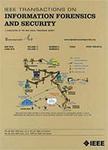版权所有:内蒙古大学图书馆 技术提供:维普资讯• 智图
内蒙古自治区呼和浩特市赛罕区大学西街235号 邮编: 010021

作者机构:Shenzhen Univ Guangdong Key Lab Intelligent Informat Proc Shenzhen 518060 Peoples R China Shenzhen Univ Shenzhen Key Lab Media Secur Shenzhen 518060 Peoples R China Shenzhen Univ Coll Elect & Informat Engn Natl Engn Lab Big Data Syst Comp Technol Shenzhen 518060 Peoples R China Shenzhen Inst Artificial Intelligence & Robot Soc Shenzhen 518172 Peoples R China Tencent Holdings Ltd Shenzhen 518057 Peoples R China Univ Cagliari Dept Math & Informat I-09100 Cagliari Italy Nanyang Technol Univ Rapid Rich Object Search Lab Singapore 639798 Singapore
出 版 物:《IEEE TRANSACTIONS ON INFORMATION FORENSICS AND SECURITY》 (IEEE信息鉴识与安全汇刊)
年 卷 期:2020年第15卷
页 面:1056-1071页
核心收录:
学科分类:0808[工学-电气工程] 08[工学] 0812[工学-计算机科学与技术(可授工学、理学学位)]
基 金:NSFC [61702340, U1636202] Natural Science Foundation of Guangdong Province, China [2017A030310382] Guangdong Province Research and Development Plan in Key Areas [2019B010139003] Science and Technology Innovation Commission of Shenzhen, China [JCYJ20180305124550725, 827/000213]
主 题:Copy-proof 2D barcode Fourier domain local binary pattern
摘 要:The traditional two-dimensional (2D) barcode has been employed in anti-counterfeiting systems as a storage media for serial numbers. However, an attack can be initiated by simply copying the 2D barcode and attaching it to a counterfeit product. In this paper, we aim at proposing an authentication scheme with a mobile imaging device for a 2D barcode. This work presents a competitive solution among the 2D barcode authentication schemes that have been verified under mobile imaging conditions. The proposed copy-proof scheme is composed of two sets of features which are extracted by exploiting the characteristics of barcoding channel models. The proposed features identify the intrinsic differences between genuine and counterfeit barcode images in the frequency and spatial domains. An efficient two-stage barcode authentication framework is then proposed by combining the two sets of features in a cascading manner. To evaluate the practicality of the proposed authentication scheme, four databases with different devices (printers, scanners, mobile cameras), barcode sizes, and barcode designs are considered in the experiments. By comparing with the existing texture descriptors and some deep learning-based approaches, it is shown that the proposed scheme has a higher authentication accuracy under various conditions, such as cross-database, cross-size and cross-pattern experiments which study the generalities of a pre-trained model towards challenging conditions commonly found in real-world scenarios. Last but not least, the proposed scheme has been evaluated under some state-of-the-art attack scenarios where the attacker employs several realizations of genuine patterns or the deep learning-based technique to produce a counterfeit copy. The source code and data for producing the results in our experiments are available at https://***/2FOlJH7.